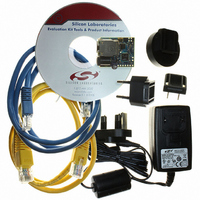CP2201EK Silicon Laboratories Inc, CP2201EK Datasheet - Page 88

CP2201EK
Manufacturer Part Number
CP2201EK
Description
KIT EVAL FOR CP2201 ETH CTRLR
Manufacturer
Silicon Laboratories Inc
Type
Controllers & Processorsr
Specifications of CP2201EK
Main Purpose
Interface, Ethernet Sensor
Embedded
Yes, MCU, 8-Bit
Utilized Ic / Part
CP2200, CP2201
Primary Attributes
Temperature and Light Sensor
Secondary Attributes
Graphic User Interface
Interface Type
Ethernet
Product
Modules
Silicon Manufacturer
Silicon Labs
Silicon Core Number
CP2201
Silicon Family Name
CP220x
Kit Contents
CP2201 Evaluation Board, Power Adapter, CAT5e Ethernet Cable, CD-ROM, Quick-Start Guide
For Use With/related Products
CP2201
Lead Free Status / RoHS Status
Contains lead / RoHS non-compliant
Lead Free Status / RoHS Status
Lead free / RoHS Compliant, Contains lead / RoHS non-compliant
Other names
336-1316
Available stocks
Company
Part Number
Manufacturer
Quantity
Price
Company:
Part Number:
CP2201EK
Manufacturer:
SiliconL
Quantity:
8
CP2200/1
15. Physical Layer (PHY)
The CP2200/1 has an IEEE 802.3 compliant 10 BASE-T Ethernet physical layer transceiver that includes a
receiver, transmitter, auto-negotiation, loopback, jabber, smart squelch, polarity correction, and link integrity
functions. If enabled, the auto-negotiation function automatically negotiates the speed of the data link and the
duplex mode. Both half-duplex and full-duplex modes are supported.
The physical layer is controlled and monitored through three registers: PHYCN, PHYCF, and PHYSTA. The various
functions and test modes that can be enabled and monitored through these registers are explained in the following
sections.
15.1. Auto-Negotiation and Duplex Mode
Auto-negotiation allows the CP2200/1 to be connected to any 10/100/1000 BASE-T Ethernet network and
advertise its capabilities. Auto-negotiation uses a series of fast link pulses to send 16-bit link code words. Many
conditions (e.g., failure to detect fast link pulses) can cause auto-negotiation to fail. On failure, the Auto-Negotiation
Failed interrupt will be generated, and/or the Auto-Negotiation Complete Interrupt will not be generated. The
PHYSTA status register will indicate the cause of failure, and the physical layer will default to half-duplex mode. On
success, the Auto-Negotiation Complete interrupt will be generated, and the Auto-Negotiation Failed interrupt will
not be generated. Both interrupts must be checked to ensure that Auto-Negotiation has succeeded.
The advertised link speed will always be 10BASE-T. The duplex mode (half or full) will be negotiated, and full
duplex will be selected if supported by the network. Full duplex mode allows the physical layer to send and receive
data at the same time. In half duplex mode, data can only be transmitted or received at any given time. Full duplex
mode provides overall higher performance and reduces collisions. Software may also choose to advertise its ability
to send and receive PAUSE control packets by setting ADPAUSE (PHYCF.2) to ‘1’.
Important Note: When using auto-negotiation, the auto-negotiation enable bit AUTONEG (PHYCF.4) must
be set to ‘1’ prior to enabling the physical layer. To restart auto-negotiation, the physical layer (transmitter,
receiver, or both) must be disabled and reenabled.
Important Note: The CP220x supports legacy link partners that cannot auto-negotiate. If the link partner cannot
autonegotiate, then the physical layer will default to half-duplex mode.
15.2. Auto-Negotiation Synchronization
The CP220x implements an autonegotiation scheme where autonegotiation is attempted for 250 ms, then a break-
link delay of 1.5 seconds is inserted between auto-negotiation attempts. When the break-link delay is active, the
CP220x does not listen for incoming auto-negotiation requests and does not attempt to auto-negotiate. If one
device starts autonegotiation while the other device is in its “break-link period”, the autonegotiation attempt will fail.
If the devices are unsyncronized, this can lead to a situation where each device attempts to autonegotiate in the
other device’s “break-link period”. This can be solved by synchronizing one or both devices using the following
procedure:
88
Step 1: Disable the physical layer by writing 0x00 to the PHYCN register.
Step 2: Enable the physical layer with link integrity test and auto-negotiation turned off.
Step 3: Poll the Wake-on-LAN interrupt flag (WAKEINT) to detect if a link partner is present.
1.Disable the transmitter power save mode (TXPWR = 0x80) and set physical layer options
2.Enable the physical layer (PHYEN = 1).
3.Wait for the physical layer to power up. See Physical Layer Startup Time in Table 22 on page 93.
4.Enable the transmitter and receiver (TXEN = 1 and RXEN = 1).
1.If there is a signal, wait 250 ms then begin autonegotiation.
2.If there is no signal, wait 1.5 seconds then begin autonegotiation.
(PHYCF = SMSQ | JABBER | ADPAUSE | AUTOPOL).
Rev. 1.0













